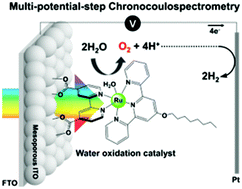Multi-potential-step chronocoulospectrometry for electrocatalytic water oxidation by a mononuclear ruthenium aquo complex immobilized on a mesoporous ITO electrode†
Abstract
A new mononuclear Ru aquo complex [Ru(C8Otpy)(H2dcbpy)(OH2)]2+ with 4,4′-dicarboxy-2,2′-bipyridine (H2dcbpy) and 4′-octyloxy-2,2′:6′,2′′-terpyridine (C8Otpy) ligands was synthesized to investigate electrocatalytic water oxidation by the complex immobilized on a mesoporous indium-doped tin oxide (meso-ITO) electrode using a multi-potential-step chronocoulospectrometric (MPSCCS) technique. UV-visible absorption spectroscopic data indicated that [Ru(C8Otpy)(dcbpy)(OH2)] (RuOH2) is deprotonated to [Ru(C8Otpy)(dcbpy)(OH)]− (RuOH) on the meso-ITO surface even at pH 5.9 of the electrolyte solution. The cyclic voltammogram (CV) of the RuOH/meso-ITO electrode showed a pH-independent redox response at E1/2 = 0.80 V vs. Ag/AgCl in the pH range of 5–12, being assigned to a non-proton-coupled 1e− redox process of RuIIOH/RuIIIOH. The MPSCCS measurement of the RuOH/meso-ITO electrode between 0.2 and 1.5 V vs. Ag/AgCl showed that RuIV species (tentatively RuIVO) exist in a steady state of the electrocatalysis in the initial stage. This suggests that the electrochemical oxidation from RuIVO to RuVO could compete with the water nucleophilic attack for O–O bond formation involved in the rate-determining step under the employed conditions. The possibility that the water nucleophilic attack on RuIVO could also compete with the electrochemical oxidation of RuIVO to RuVO was suggested by the electrocatalytic water oxidation at a low applied potential of 1.4 V prior to the formation potential of RuVO. The MPSCCS measurement at 1.4 V for 1 h showed that RuOH is gradually transformed into an alternative catalyst (most likely RuOx nanoparticles) on the electrode. The MPSCCS technique is promising to reveal the redox reactions and catalytic aspects of molecular catalysts immobilized on an electrode for water oxidation.

- This article is part of the themed collection: Metal Complexes and Inorganic Materials for Solar Fuel Production


 Please wait while we load your content...
Please wait while we load your content...